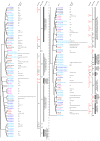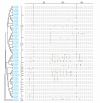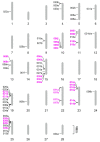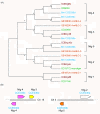Genomic analysis of carboxyl/cholinesterase genes in the silkworm Bombyx mori
- PMID: 20546589
- PMCID: PMC3017765
- DOI: 10.1186/1471-2164-11-377
Genomic analysis of carboxyl/cholinesterase genes in the silkworm Bombyx mori
Abstract
Background: Carboxyl/cholinesterases (CCEs) have pivotal roles in dietary detoxification, pheromone or hormone degradation and neurodevelopment. The recent completion of genome projects in various insect species has led to the identification of multiple CCEs with unknown functions. Here, we analyzed the phylogeny, expression and genomic distribution of 69 putative CCEs in the silkworm, Bombyx mori (Lepidoptera: Bombycidae).
Results: A phylogenetic tree of CCEs in B. mori and other lepidopteran species was constructed. The expression pattern of each B. mori CCE was also investigated by a search of an expressed sequence tag (EST) database, and the relationship between phylogeny and expression was analyzed. A large number of B. mori CCEs were identified from a midgut EST library. CCEs expressed in the midgut formed a cluster in the phylogenetic tree that included not only B. mori genes but also those of other lepidopteran species. The silkworm, and possibly also other lepidopteran species, has a large number of CCEs, and this might be a consequence of the large cluster of midgut CCEs. Investigation of intron-exon organization in B. mori CCEs revealed that their positions and splicing site phases were strongly conserved. Several B. mori CCEs, including juvenile hormone esterase, not only showed clustering in the phylogenetic tree but were also closely located on silkworm chromosomes. We investigated the phylogeny and microsynteny of neuroligins in detail, among many CCEs. Interestingly, we found the evolution of this gene appeared not to be conserved between B. mori and other insect orders.
Conclusions: We analyzed 69 putative CCEs from B. mori. Comparison of these CCEs with other lepidopteran CCEs indicated that they had conserved expression and function in this insect order. The analyses showed that CCEs were unevenly distributed across the genome of B. mori and suggested that neuroligins may have a distinct evolutionary history from other insect order. It is possible that such an uneven genomic distribution and a unique neuroligin evolution are shared with other lepidopteran insects. Our genomic analysis has provided novel information on the CCEs of the silkworm, which will be of value to understanding the biology, physiology and evolution of insect CCEs.
Figures






Similar articles
-
Molecular characterization and functional analysis of novel carboxyl/cholinesterases with GQSAG motif in the silkworm Bombyx mori.Insect Biochem Mol Biol. 2010 Feb;40(2):100-12. doi: 10.1016/j.ibmb.2009.12.015. Epub 2010 Jan 7. Insect Biochem Mol Biol. 2010. PMID: 20060470
-
Large scale full-length cDNA sequencing reveals a unique genomic landscape in a lepidopteran model insect, Bombyx mori.G3 (Bethesda). 2013 Sep 4;3(9):1481-92. doi: 10.1534/g3.113.006239. G3 (Bethesda). 2013. PMID: 23821615 Free PMC article.
-
Extensive conserved synteny of genes between the karyotypes of Manduca sexta and Bombyx mori revealed by BAC-FISH mapping.PLoS One. 2009 Oct 15;4(10):e7465. doi: 10.1371/journal.pone.0007465. PLoS One. 2009. PMID: 19829706 Free PMC article.
-
Genome-wide identification and characterization of Fox genes in the silkworm, Bombyx mori.Funct Integr Genomics. 2015 Sep;15(5):511-22. doi: 10.1007/s10142-015-0440-5. Epub 2015 Apr 17. Funct Integr Genomics. 2015. PMID: 25893708 Review.
-
Molecular Functions and Physiological Roles of Gustatory Receptors of the Silkworm Bombyx mori.Int J Mol Sci. 2024 Sep 21;25(18):10157. doi: 10.3390/ijms251810157. Int J Mol Sci. 2024. PMID: 39337641 Free PMC article. Review.
Cited by
-
A carboxylesterase, Esterase-6, modulates sensory physiological and behavioral response dynamics to pheromone in Drosophila.BMC Biol. 2012 Jun 21;10:56. doi: 10.1186/1741-7007-10-56. BMC Biol. 2012. PMID: 22715942 Free PMC article.
-
Identification and Expression Patterns of Putative Diversified Carboxylesterases in the Tea Geometrid Ectropis obliqua Prout.Front Physiol. 2017 Dec 18;8:1085. doi: 10.3389/fphys.2017.01085. eCollection 2017. Front Physiol. 2017. PMID: 29326608 Free PMC article.
-
Molecular and functional characterization of cDNAs putatively encoding carboxylesterases from the migratory locust, Locusta migratoria.PLoS One. 2014 Apr 10;9(4):e94809. doi: 10.1371/journal.pone.0094809. eCollection 2014. PLoS One. 2014. PMID: 24722667 Free PMC article.
-
Host plant adaptation in the polyphagous whitefly, Trialeurodes vaporariorum, is associated with transcriptional plasticity and altered sensitivity to insecticides.BMC Genomics. 2019 Dec 19;20(1):996. doi: 10.1186/s12864-019-6397-3. BMC Genomics. 2019. PMID: 31856729 Free PMC article.
-
Characterization of an antennal carboxylesterase from the pest moth Spodoptera littoralis degrading a host plant odorant.PLoS One. 2010 Nov 29;5(11):e15026. doi: 10.1371/journal.pone.0015026. PLoS One. 2010. PMID: 21124773 Free PMC article.
References
-
- Oakeshott JG, Claudianos C, Campbell PM, Newcomb RD, Russell RJ. In: Comprehensive Molecular Insect Science-Pharmacology. Gilbert LI, Iatrou K, Gill SS, editor. Vol. 5. Oxford: Elsevier; 2005. Biochemical genetics and genomics of insect esterases; pp. 309–381. full_text.
-
- Riddiford LM. Cellular and molecular actions of juvenile hormone 1. General considerations and premetamorphic actions. Advances in Insect Physiology. 1994;24:213–274. full_text.
-
- Wyatt GR, Davey KG. Cellular and molecular actions of juvenile hormone 2. Roles of juvenile hormone in adult insects. Advances in Insect Physiology. 1996;26:1–155. full_text.
-
- Jallon JM, Wicker-Thomas C. In: Insect Pheromone Biochemistry and Molecular Biology. Blomquist GJ, Vogt RG, editor. Oxford: Elsevier; 2003. Genetic studies on pheromone production in Drosophila; pp. 253–281. full_text.
MeSH terms
Substances
LinkOut - more resources
Full Text Sources
Research Materials

